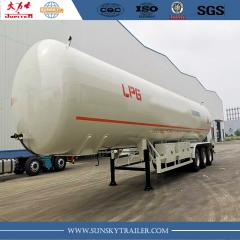-
 3 Axle Lpg Gas Tank Semi Trailer
3 Axle Lpg Gas Tank Semi Trailer
-
 Low Bed Trailer
Low Bed Trailer
-
 SHACMAN F3000 Tractor Truck
SHACMAN F3000 Tractor Truck
-
 Flatbed Pillar Trailer
Flatbed Pillar Trailer
SUNSKY VEHICLE, a manufacturer of flatbed semi-trailers, has found that the Flatbed Pillar Trailer i...
Massive quantities of hazardous substances and chemicals, such as acids, endanger human health and harm the environment as a whole.
The industrial production of such chemicals occurs all over the world, and it is done with extreme caution, particularly in the location of production. However, these acids, for example, would need to be transported to various locations around the world. When it comes to directing the flow of products to customers, transportation is critical.
As a result, some modes of transport for acids would necessitate more specialized packaging than other types of goods. Acid storage and transportation have become more common as technology and manufacturing have advanced.
What is an acid tanker?
An acid tanker is a vessel used to transport various acids such as sulfuric acid, hydrochloric acid, hydrofluoric acid, nitric acid, and acetic acid, among others, for various industrial applications. Acids differ in their chemical and physical properties. In that case, different acids necessitate the use of different materials in the construction of their respective tankers. However, it is not necessary to have a different type of tanker for each type of acid.
Let’s talk about some major characteristics of an acid tanker:
· Structure
The dilute sulfuric acid, the hydrochloric acid tanker has multiple layers. The outer structure is made of stainless steel or an aluminum alloy in some cases. The tank's interior is lined with Polyethylene (PE). Despite being made in separate processes, both the outer shell and the inner PE liner become part of the entire acid tank trailer.
· Material
The multilayered structure of the dilute sulfuric acid, the hydrochloric acid tanker is made of stainless steel or an aluminum alloy. Stainless steel has typically been the primary structural material used for these types of tanks. Steel is vulnerable to only a few products, the majority of which are acids.
· Corrosion
To prevent corrosion from spreading to other parts of the tank, all flanges are typically made of plastic. Plastics are naturally non-corrosive, even when exposed to strong chemicals such as sulfuric acid and hydrochloric acid. This is due to their non-reactive nature with the vast majority of materials encountered. This aids in keeping the tank trailer from corroding.
· Safety measures
It is correct that acid tank trailers cannot corrode. Standard safety checks and procedures, on the other hand, should be performed on all chemical tank trailers. The service life of these storage tanks is typically estimated to be between 20 and 40 years. To ensure the safe operation of a storage tank, the thickness of the tank should be checked at least once every two years, and at least once every five years for an internal inspection.
Wrapping up
Acid tankers are specially designed to transport a wide range of liquid chemical cargoes. The bulk liquid chemicals, acids, edible oils, alcohols, biofuels, and clean petroleum products carried are mostly sophisticated.
Because of the complexities of these compounds, zinc-coated or stainless steel tanks, sophisticated acid tankers, and technical crews capable of handling sometimes toxic, flammable, or corrosive products are required.
Follow https://www.sunskytrailer.com/ for more information on tankers and much more.




